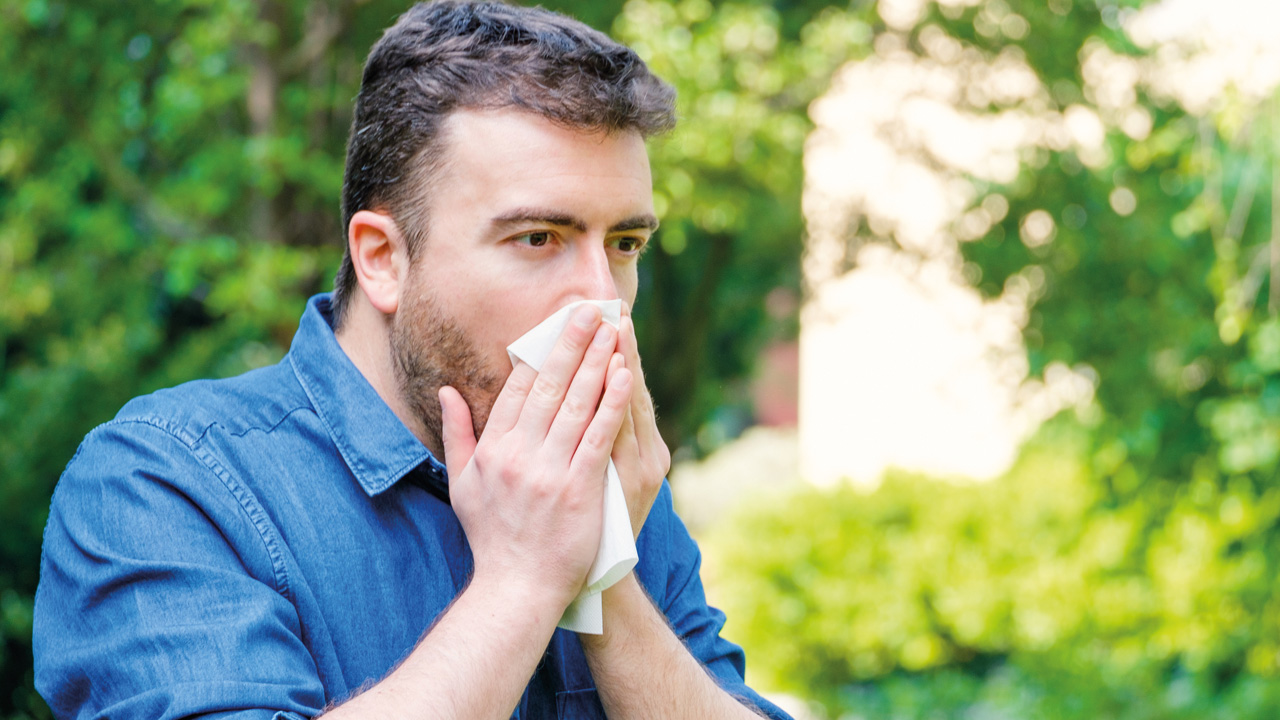In Clinical
Follow this topic
Bookmark
Record learning outcomes
Hay fever (seasonal allergic rhinitis) is an allergic reaction to pollen characterised by inflammation of the mucous membranes of the nose and eyes.
Symptoms
- Sneezing and coughing
- Itching inside nose, mouth, throat and ears
- Rhinorrhoea (runny nose)
- Congestion (blocked nose)
- Reduced sense of smell
- Itchy, watery eyes
- Headache
- Earache
- Tiredness
(Sources: NICE – Allergic rhinitis; BSACI guideline)
May be mild (no impact on quality of life)
Moderate-severe – impact on daily activities and/or sleep
Allergic rhinitis and asthma:
- AR is a risk factor for the development of asthma and can impair asthma control
- Estimated 80 per cent of people with asthma also suffer from hayfever.
Causes/Triggers
A combination of genetic factors/genetic predisposition and exposure to pollen usually from trees, grasses or weeds.

Diagnosis
Hay fever is usually diagnosed on the basis of:
- Typical symptoms appearing after exposure to pollens
- Absence of symptoms outside pollen season
- +/– family history of hay fever.
Management
When the pollen count is high (over 50 particles/cubic metre)
- Stay indoors
- Damp-dust and vacuum clean regularly
- Keep windows and doors closed
- Avoid bringing pollen into the house (e.g. on laundry or pets)
- Shower and change clothes to remove pollen
If outdoors:
- Avoid places where pollen is abundant (e.g. grassy areas)
- Wear wraparound sunglasses
- Keep car windows closed and/or fit pollen filter in air vent
Check pollen forecasts – consider using a pollen forecasting app
Apply a smear of petroleum jelly inside the lower nostrils to prevent pollen from entering
Use saline nasal rinses
If itchy, inflamed eyes are a problem, consider using a cold eye compress, allergy eye spray, allergy eye drops (sterile, isotonic).
Pollen
Pollen count = the number of grains of pollen in one cubic metre of air.
| Grade | Grains per m3 of air |
| Low | < 30 |
| Moderate | 30-49 |
| High | 50-149 |
| Very high | > 150 |
Weather or not?
There is a complex relationship between the weather and the distribution of pollen, with rain, wind, temperature and sunshine all affecting how much pollen will be produced and how far it will be dispersed, says the Met Office.
Any rainfall causes a marked decrease in pollen concentration in the air, but when and how much it rains is an important factor. While early, heavy and prolonged rain is likely to keep counts low all day, rain in the afternoon will have less impact.
Temperature is another factor when it comes to pollen release. For grass pollen, a maximum temperature of between 18-28°C could result in a high count if it is a dry day with low humidity and a gentle breeze. Trees respond best when the temperature range is between 13-15°C. However, if the temperature rises above 28°C, then pollen levels decrease. Several warm days in a row can see the dispersal of pollen adversely affected.
While wind is needed to disperse pollen, this can be another variable factor as different types of pollen need different wind speeds for ideal dispersion. Birch pollen, for example, needs moderate to high winds but if the wind is too light pollen will barely get off the ground to be dispersed. Too windy and the pollen gets blown further afield and thins out significantly.
Source: The Met Office
Worcester source
The University of Worcester produces the pollen forecast for the whole of the UK in conjunction with the Met Office.
Real-time pollen monitoring means pollen grains are detected and counted by an internet-enabled device and the data sent immediately out to the public. There are now several laser detection machines that are being trialled by scientists at the University of Worcester.
The effects of climate change on the UK pollen season has recently been studied (Adams-Groom et al. 2022). Results showed that the birch tree pollen season is getting more severe, the oak and grass pollen seasons are getting earlier, and grass pollen seasons are not getting more severe, as may have been suspected. All these trends regarding the pollen season are in line with research from nearby European countries.
Increasing spring and summer temperatures were found to be driving these patterns, as well as some changes in land use, such as increasing woodland and urbanisation reducing grassland area.
Pollen forecasts are available on a regional basis to cover the whole of the UK including Northern Ireland. They can also be provided in detail for individual regions. Daily pollen and spore forecasts are issued from mid-March to early October.
Further reading and key references
- NICE – Allergic rhinitis (revised Dec 2022)
- Scadding GK et al. BSACI guideline for the diagnosis and management of allergic and non-allergic rhinitis (Revised Edition 2017; First edition 2007) Clin Exp Allergy. 2017; 47:856–889.


